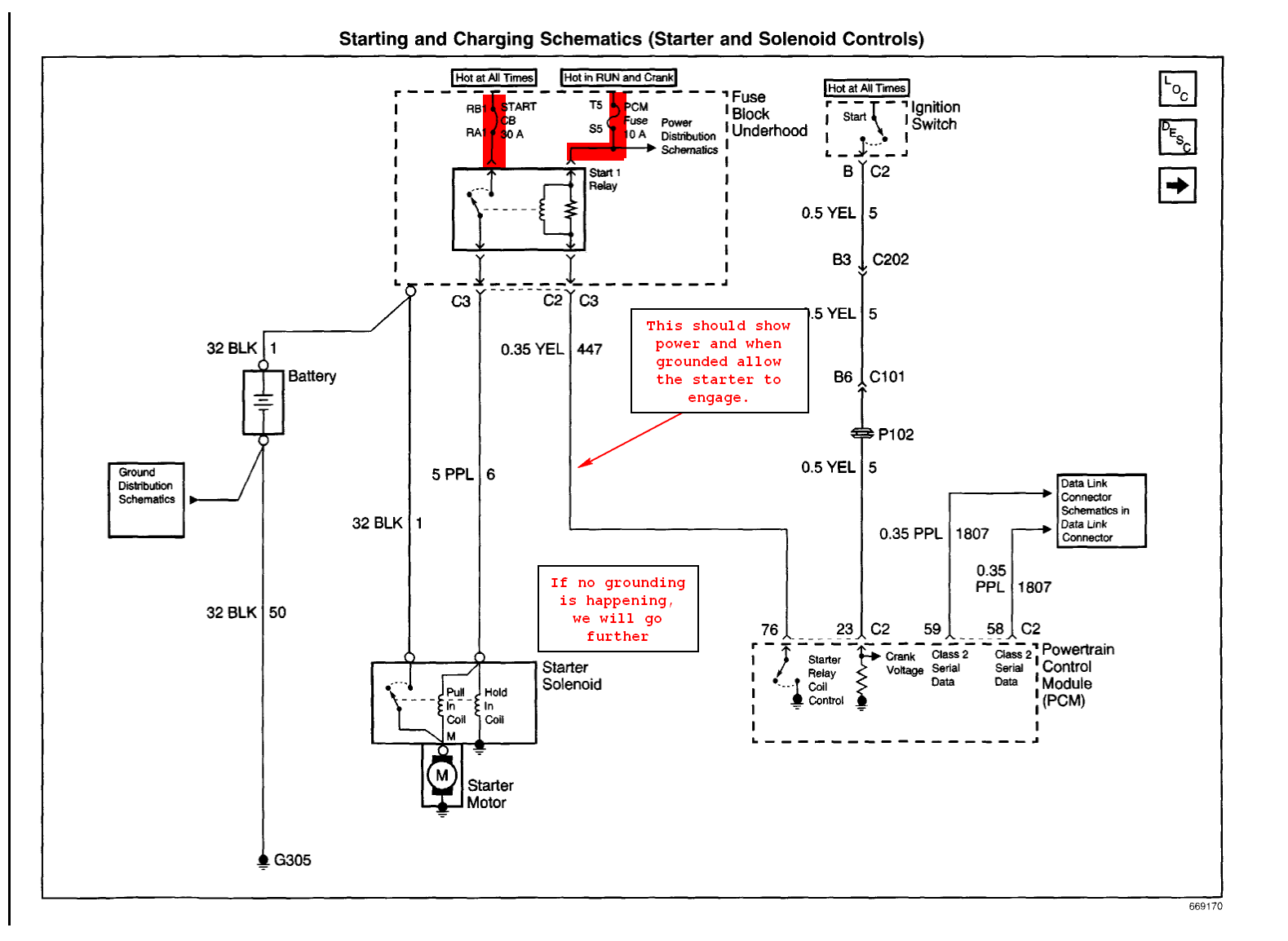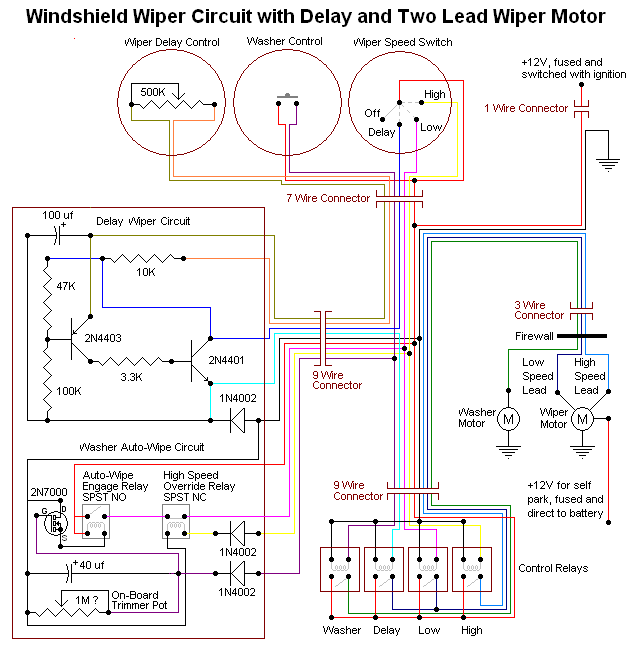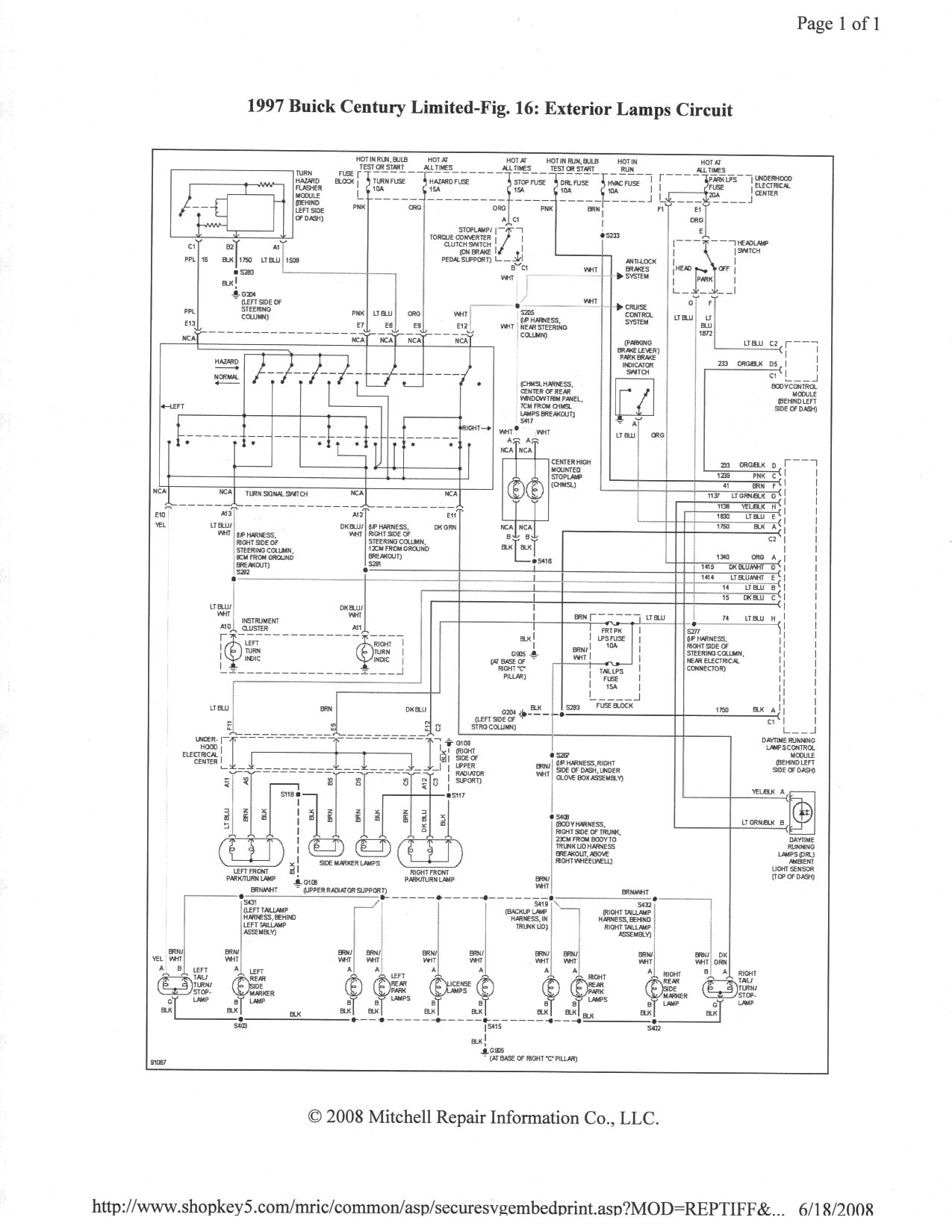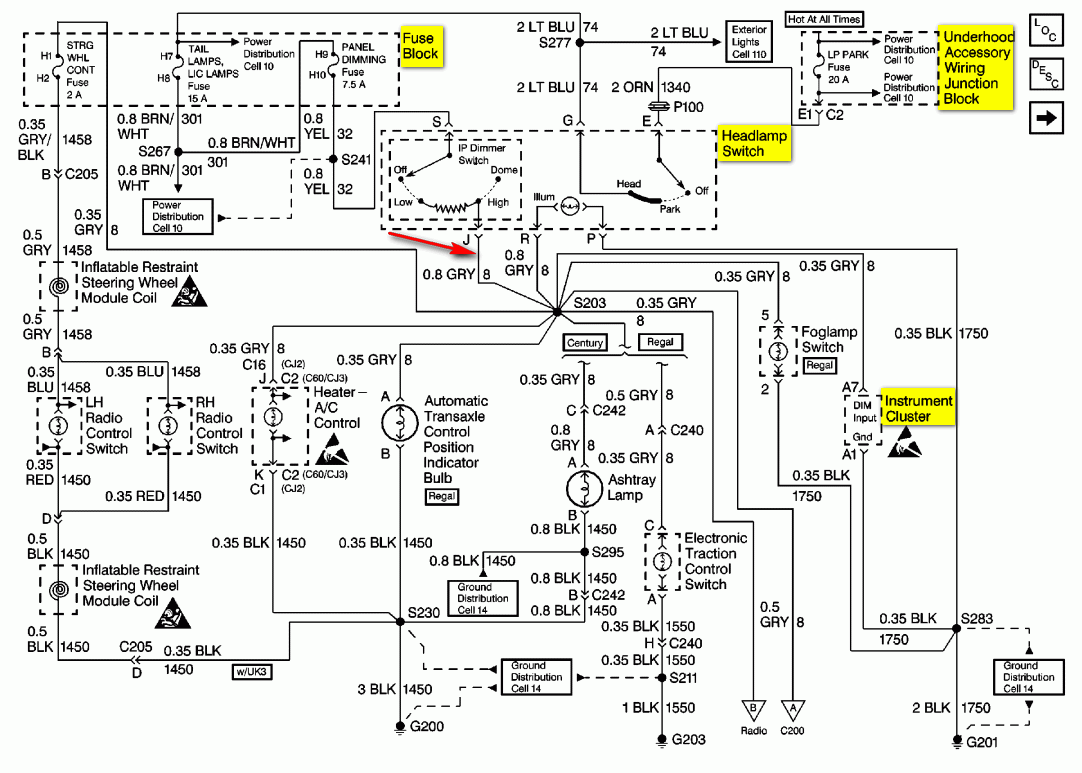
01 buick lesabre

In this diagram, check for battery voltage at specific points. It is not necessary to check every point, just enough to confirm that all areas have power. Fuses 22 and 23 are blown; replacing them is advisable, though they are not the primary issue. Examine the STARTER relay as indicated in the diagram. The target areas for 12 volts are marked in red. Verify if the computer is grounding the relay as shown. One side of the relay's magnet is connected to either terminal 85 or 86, which should indicate power regardless of the relay's position. Terminal 30 should have constant power, but when the relay was removed, terminal 87 was observed to have power instead. Terminal 30 is the power input from the circuit breaker. Terminals 85 and 86 are the magnet connections that close the circuit when energized. One of these terminals receives power from the PCM fuse, while the other is grounded by the PCM. When the relay closes, power from terminal 30 flows to terminal 87, which connects to the starter. If the PCM fuse is faulty, there will be no power to the starter solenoid or communication with the PCM. Feeding power to the line at the relay from the PCM fuse should activate the system. The circuit breaker may become warm as current flows through it. Confirm that terminal 30 has 12 volts with the relay connected. The next steps involve checking if power reaches the PCM fuse and why it does not connect to the relay or PCM. If a faulty wire is suspected, a bypass may be performed after confirming initial findings. The absence of power at the PCM fuse needs to be addressed to restore functionality. The IGN-1 relay in the under-hood fuse box should be examined next. A pink wire from the ignition switch should provide power when the key is in the run position. The ground may be connected through the fuse box. Terminal 87 should have constant battery voltage, and when the key is turned to run, power should flow into the pink wire, allowing power to exit through terminal 30. This process powers multiple components, not just the PCM and starter relay. Jumping terminals 87 to 30 should activate the system if power is present. Further investigation revealed 12 volts at the IGN1 slot, but jumping to terminal 30 did not result in cranking. Efforts to locate a common ground continue, including cleaning the body ground near the battery and the positive connection on the under-hood fuse box. The ground G-103 was found with some corrosion and was cleaned.
The circuit schematic involves a relay system that plays a crucial role in the starting mechanism of the vehicle. The relay is typically a five-terminal component, with terminals numbered 30, 87, 85, and 86. Terminal 30 serves as the power input from the circuit breaker, providing a constant voltage supply. Terminal 87 is the output terminal that connects to the starter solenoid, allowing it to engage when the relay is activated. The terminals 85 and 86 are designated for the relay's coil, where one terminal receives power from the PCM fuse, while the other is connected to ground, typically through the PCM itself.
When the ignition switch is turned to the "run" position, power should flow through the pink wire to either terminal 85 or 86, energizing the relay coil. This action causes the relay to close, which connects terminal 30 to terminal 87, thereby supplying power to the starter solenoid. If the relay does not activate, it may indicate a failure in the PCM fuse, a faulty relay, or issues with the ground connections.
To troubleshoot effectively, the voltage at terminal 30 should be verified with the relay installed. If no voltage is present, the circuit breaker or associated wiring may be faulty. Conversely, if voltage is confirmed but the starter does not engage, further investigation into the relay operation and the integrity of the ground connections is warranted.
In this scenario, cleaning corroded ground connections is a critical step as poor grounding can lead to insufficient current flow, preventing the relay from functioning correctly. Additionally, if bypassing the relay by connecting terminal 87 directly to terminal 30 results in the starter engaging, it confirms that the relay or its control circuit is the issue. This systematic approach to diagnosing the relay and power distribution will help identify the root cause of the starting problem and restore the vehicle's functionality.In this diagram, look to see if you have battery voltage at these points. You don`t have to check every point, just enough of them to confirm that all points have power. Let me know and I`ll bring you to the next level after you report back. Ok Dave, fuses 22 and 23 are blown,replace those, they are not your main problem, but blown so let`s fix them. Go to the STARTER 1 Relay and look at my diagram. Let me know what you find there. You want 12 volts at the areas I marked in red. Look to see if the computer is grounding the relay as indicated in my diagram. It is one side of the magnet of the relay, See if you have a diagram and check both for the magnet. It is usually 85 or 86 if labeled as so, It should show power with the relay in or out. i need to understand the relay. on the side is the schematic, when you turn it over the numbers are upside down 87, 85, 86 and 30. left to right top to bottom. i think 30 should have power all the time, but when the relay came out it was 87. maybe nothing. I turned the relay around were 30 had positive power but still no cranking. Ok, 30 is the power in from the circuit breaker. 85 and 86 are the two sides of the magnet that when energizes causes the relay to close the circuit. One side of the magnet is 85 or 86 and gets power from the PCM fuse. The other side of the magnet, either 85 or 86 is the ground from the PCM that when grounded closes the relay. When that relay closes the power from 30 flows out on 87 which is the purple to the starter. Recheck your PCM fuse and and replace it with a known good fuse. If that fuse is dead, you will get no power to the starter solenoid as well as no activity in the PCM, such as what you are experiencing.
Either the fuse is faulty or the connection to the fuse if faulty or the link between the fuse and the rest of the circuit is faulty. If you feed power to the line at the relay that comes from the PCM fuse, the system should come alive.
Let me know and I`ll tell you where to go from here after you redigest how the relay works. The circuit breaker will get warm as current is passing through. Double check pin 30 for 12 volts with the relay plugged in. Let me know if you have power there. You`re welcome Dave. Here is what we are going to look at tomorrow. First if we are getting power to the PCM fuse, why that power is not making it to the relay or the PCM. If we suspect a faulty wire, we will do a bypass, but we are going to confirm some things first. We now know why it won`t crank or no communication from the PCM, soon we will know what to do to fix it.
Happy New Year to you too Dave. Ok, so just to confirm, no power at the PCM fuse, right I will find out where it comes from if you tell me so. We fix that, you will be back in business, and we will do it in 2012 :) Ok, go to the IGN-1 relay in the underhood fuse box.
From what I can tell, there is a pink wire that gets powered From the ignition switch in run. I suspect ground is grounded through the fuse box, I am not certain of that yet. 87 should have battery voltage all the time. When you turn the key to run, power should go in on that pink, which is either 85 or 86, when the other 85 or 86 is grounded, power will switch and send power out on 30. When power flows out on 30 everything gets powered up, more things than just the PCM and start relay, A/c componenents and other stuff.
Look there. If you jump 87 to 30 at that relay, everything should come alive. provided you have power on 87 im back at it. i found 12v at IGN1 slot # XXXXX i jumped across #30 but no crank. Ive been looking for that common ground and still looking. Im gonna pull the body ground next to the battery and clean it and the positive off the fuse box under the hood and clean it. I found the ground g-103 it had slight green to it, i cleande it with battery cleaner, it should be good.
the positive to 🔗 External reference
The circuit schematic involves a relay system that plays a crucial role in the starting mechanism of the vehicle. The relay is typically a five-terminal component, with terminals numbered 30, 87, 85, and 86. Terminal 30 serves as the power input from the circuit breaker, providing a constant voltage supply. Terminal 87 is the output terminal that connects to the starter solenoid, allowing it to engage when the relay is activated. The terminals 85 and 86 are designated for the relay's coil, where one terminal receives power from the PCM fuse, while the other is connected to ground, typically through the PCM itself.
When the ignition switch is turned to the "run" position, power should flow through the pink wire to either terminal 85 or 86, energizing the relay coil. This action causes the relay to close, which connects terminal 30 to terminal 87, thereby supplying power to the starter solenoid. If the relay does not activate, it may indicate a failure in the PCM fuse, a faulty relay, or issues with the ground connections.
To troubleshoot effectively, the voltage at terminal 30 should be verified with the relay installed. If no voltage is present, the circuit breaker or associated wiring may be faulty. Conversely, if voltage is confirmed but the starter does not engage, further investigation into the relay operation and the integrity of the ground connections is warranted.
In this scenario, cleaning corroded ground connections is a critical step as poor grounding can lead to insufficient current flow, preventing the relay from functioning correctly. Additionally, if bypassing the relay by connecting terminal 87 directly to terminal 30 results in the starter engaging, it confirms that the relay or its control circuit is the issue. This systematic approach to diagnosing the relay and power distribution will help identify the root cause of the starting problem and restore the vehicle's functionality.In this diagram, look to see if you have battery voltage at these points. You don`t have to check every point, just enough of them to confirm that all points have power. Let me know and I`ll bring you to the next level after you report back. Ok Dave, fuses 22 and 23 are blown,replace those, they are not your main problem, but blown so let`s fix them. Go to the STARTER 1 Relay and look at my diagram. Let me know what you find there. You want 12 volts at the areas I marked in red. Look to see if the computer is grounding the relay as indicated in my diagram. It is one side of the magnet of the relay, See if you have a diagram and check both for the magnet. It is usually 85 or 86 if labeled as so, It should show power with the relay in or out. i need to understand the relay. on the side is the schematic, when you turn it over the numbers are upside down 87, 85, 86 and 30. left to right top to bottom. i think 30 should have power all the time, but when the relay came out it was 87. maybe nothing. I turned the relay around were 30 had positive power but still no cranking. Ok, 30 is the power in from the circuit breaker. 85 and 86 are the two sides of the magnet that when energizes causes the relay to close the circuit. One side of the magnet is 85 or 86 and gets power from the PCM fuse. The other side of the magnet, either 85 or 86 is the ground from the PCM that when grounded closes the relay. When that relay closes the power from 30 flows out on 87 which is the purple to the starter. Recheck your PCM fuse and and replace it with a known good fuse. If that fuse is dead, you will get no power to the starter solenoid as well as no activity in the PCM, such as what you are experiencing.
Either the fuse is faulty or the connection to the fuse if faulty or the link between the fuse and the rest of the circuit is faulty. If you feed power to the line at the relay that comes from the PCM fuse, the system should come alive.
Let me know and I`ll tell you where to go from here after you redigest how the relay works. The circuit breaker will get warm as current is passing through. Double check pin 30 for 12 volts with the relay plugged in. Let me know if you have power there. You`re welcome Dave. Here is what we are going to look at tomorrow. First if we are getting power to the PCM fuse, why that power is not making it to the relay or the PCM. If we suspect a faulty wire, we will do a bypass, but we are going to confirm some things first. We now know why it won`t crank or no communication from the PCM, soon we will know what to do to fix it.
Happy New Year to you too Dave. Ok, so just to confirm, no power at the PCM fuse, right I will find out where it comes from if you tell me so. We fix that, you will be back in business, and we will do it in 2012 :) Ok, go to the IGN-1 relay in the underhood fuse box.
From what I can tell, there is a pink wire that gets powered From the ignition switch in run. I suspect ground is grounded through the fuse box, I am not certain of that yet. 87 should have battery voltage all the time. When you turn the key to run, power should go in on that pink, which is either 85 or 86, when the other 85 or 86 is grounded, power will switch and send power out on 30. When power flows out on 30 everything gets powered up, more things than just the PCM and start relay, A/c componenents and other stuff.
Look there. If you jump 87 to 30 at that relay, everything should come alive. provided you have power on 87 im back at it. i found 12v at IGN1 slot # XXXXX i jumped across #30 but no crank. Ive been looking for that common ground and still looking. Im gonna pull the body ground next to the battery and clean it and the positive off the fuse box under the hood and clean it. I found the ground g-103 it had slight green to it, i cleande it with battery cleaner, it should be good.
the positive to 🔗 External reference



